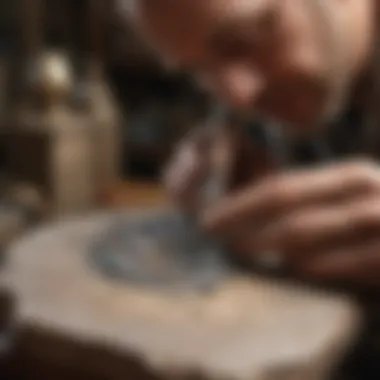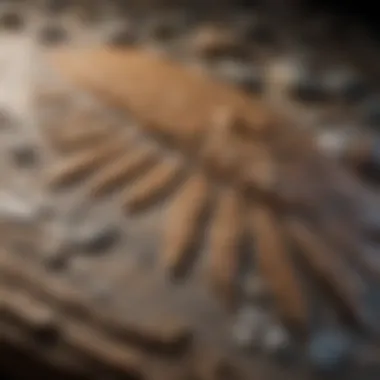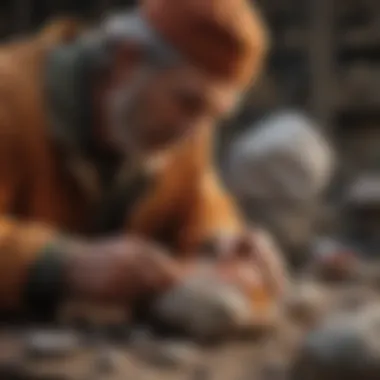Choosing the Best Glue for Stones: A Comprehensive Guide for Rock and Fossil Enthusiasts


Rock and Fossil Iedntification
In the vast realm of rock and fossil collecting, the identification of stones plays a pivotal role. Understanding the types of rocks and fossils is fundamental to appreciating their unique characteristics. Tools such as magnifying glasses, UV lights, and hardness testing kits are indispensable for discerning collectors seeking to delve into the world of geological wonders. Immerse yourself in the exploration of various textures, colors, and formations that define each rock and fossil type.
Collecting Tips and Techniques
Embarking on a collecting expedition requires meticulous planning and execution. Best practices encompass thorough research on potential collecting sites and obtaining necessary permits to ensure a responsible approach to rock and fossil gathering. Locating prime sites demands a keen eye for geological formations, with knowledge of the terrain and local regulations. When it comes to extracting specimens, utilizing the right tools like chisels, brushes, and safety gear is paramount for both effectiveness and safety.
Preservation and Diplay
Preserving the integrity of your precious rock and fossil specimens is crucial for maintaining their beauty and scientific value. Techniques such as consolidating fragile rocks and stabilizing fossils require precision and expertise. Proper storage methods include utilizing acid-free containers, silica gel packs for humidity control, and secure shelving to prevent damage. Unleash your creativity in displaying your collection with innovative ideas like shadow boxes, LED lighting, and custom-made stands to showcase the unique allure of each specimen.
Geological Insights
Delve into the captivating world of geological formations and processes that have shaped the Earth over millennia. Explore the historical significance of various rocks and fossils, unraveling their stories embedded in time. From renowned discoveries in paleontology to groundbreaking findings in mineralogy, each revelation offers a glimpse into the dynamic evolution of our planet. Immerse yourself in the wonder of geology, from ancient rocks to fossilized remains, and witness the endless discoveries awaiting in the field.
Introduction
In the vast universe of rock and fossil collecting, the adhesive that holds everything together, quite literally, plays a vital role. The adhesive you choose can make or break the longevity and integrity of your prized geological specimens. Selecting the right glue for stonework is an art that requires knowledge, precision, and a deep understanding of the properties of both the adhesive and the stones themselves. This guide aims to unravel the complexities surrounding adhesives for rocks and fossils, equipping enthusiasts with the know-how to make informed decisions that will safeguard their collections for generations to come.
Understanding the Importance of Choosing the Right Glue


When delving into the world of rock and fossil collection, one quickly realizes that preservation is paramount. Stones, with their intricate textures, shapes, and historical significance, demand meticulous care and attention when joining broken pieces or securing delicate formations. The choice of glue holds immense significance in this process, as it can dictate the durability, aesthetics, and overall value of the specimen being worked on. Understanding the importance of selecting the right glue goes beyond mere practicality; it is a testament to the dedication and passion that collectors have for their treasures.
From the perspective of a rock or fossil collector, the adhesive serves as a silent guardian, ensuring that every fragment, no matter how small, remains securely in place. Different stones have varying porosities, densities, and chemical compositions, all of which interact uniquely with adhesives. Delving into the nuances of epoxy resins, cyanoacrylate super glues, and polyurethane adhesives unveils a world where scientific precision meets artistic finesse. The adhesive chosen must strike a delicate balance between strength and subtlety, seamlessly blending into the stone's natural features while providing robust structural support.
A critical aspect that amplifies the importance of correct glue selection is the historical and geological significance of the specimens themselves. Each rock or fossil carries within it a story that spans millions of years, capturing moments in Earth's history that are irreplaceable. Preserving these narratives requires a glue that not only bonds the physical fragments but also respects the cultural and scientific heritage encapsulated within. As such, choosing the right adhesive becomes a gesture of reverence towards the natural world and a commitment to safeguarding its wonders for future generations to admire and study.
The next time you embark on a journey to repair a broken trilobite fossil or secure an intricate mineral formation, remember that the glue you wield is more than just a bonding agent. It is a bridge between past and present, a conduit that spans epochs and connects human hands with the timeless beauty of Earth's geological treasures.
Types of Gluten for Stone
When delving into the realm of choosing the right glue for stones, the discussion inevitably shifts towards understanding the varied types of glue available in the market. This pivotal topic forms the backbone of this article, aiming to provide rock and fossil collectors with a comprehensive overview of the different adhesive options tailored for stone applications. By exploring the specific elements, benefits, and considerations associated with various types of glue for stone, readers can gain valuable insights into selecting the most suitable adhesive for their geological projects.
Epoxy Adhesives
Epoxy adhesives stand out as a cornerstone in the realm of stone bonding due to their exceptional structural strength and versatility. In the realm of stone restoration and preservation, knowing the nuances between epoxy resins and epoxy glues is paramount. Epoxy resins offer unparalleled bonding capabilities while epoxy glues provide ease of use. This subtle yet crucial difference plays a vital role in determining the adhesive's application efficiency and longevity. The benefits of using epoxy adhesives on stone are multifaceted, ranging from high resistance to chemicals and moisture to seamless color matching for aesthetic repairs. The unique feature of epoxy adhesives lies in their ability to create durable and invisible bonds, making them a preferred choice for securing stones effectively.
Cyanoacrylate (Super Glue)
Cyanoacrylate adhesives, commonly known as super glue, offer distinct advantages and challenges when used in stone applications. Understanding their suitability for different types of stone is key to optimizing their adhesive properties. Super glue excels in bonding non-porous stones due to its rapid curing and high bonding strength. However, potential issues may arise when using cyanoacrylate adhesives with porous stones, leading to inconsistent adhesion and discoloration. Navigating these nuances is essential for rock and fossil collectors seeking to leverage the benefits of super glue while mitigating its drawbacks. Despite its challenges, super glue remains a popular choice for quick and strong bonding solutions in the world of stone maintenance.
Polyurethane Adhesives
Polyurethane adhesives present a compelling alternative for stone bonding, offering a balance between strength and flexibility. Exploring the advantages and limitations of polyurethane adhesives sheds light on their applicability in various stone projects. The key characteristic of polyurethane adhesives lies in their ability to withstand environmental extremes and vibrations, making them suitable for outdoor stone installations. While polyurethane adhesives provide durable bonds, they may have limitations in terms of curing time and visibility in transparent or light-colored stones. Understanding these nuances empowers rock and fossil collectors to make informed decisions when choosing polyurethane adhesives for their geological collections.


By meticulously examining the nuances of each glue type, readers can navigate the diverse landscape of stone adhesives with confidence, armed with the knowledge needed to preserve and repair their rock and fossil treasures effectively.
Factors to Consider When Choosing Glue for Stones
Choosing the right type of glue for stones is paramount for rock and fossil collectors. Among the various factors to contemplate, one of the key elements is the porosity and absorbency of the stone. Porosity refers to the degree of empty spaces within the stone, affecting how well it can absorb the adhesive. Understanding the porosity helps in selecting a glue that can effectively bond with the stone's surface. Stones with high porosity require adhesives with good penetration capabilities to ensure a strong bond. On the other hand, less porous stones need adhesives that can adhere well to the surface without excessive absorption. The absorbency of the stone plays a crucial role in determining the application method and amount of glue needed for a secure bond. It is vital to assess the porosity and absorbency of the stone before choosing the appropriate glue to achieve optimal results.
Porosity and Absorbency of the Stone
Porosity and absorbency are critical factors when selecting glue for stones. The porosity of the stone impacts the adhesive's ability to penetrate and bond effectively. High porosity stones require adhesives with good penetration properties, ensuring a strong and durable bond. On the other hand, stones with low porosity may need adhesives that can adhere well to the surface without excessive absorption. Understanding the absorbency of the stone helps determine the amount of glue required for a secure bond. Proper assessment of these factors is essential in choosing the right adhesive for different types of stones and ensuring successful bonding.
Setting Time and Curing Process
Another vital consideration when choosing glue for stones is the setting time and curing process. The setting time refers to the duration it takes for the adhesive to bond the stones together firmly. A shorter setting time is beneficial for tasks requiring quick bonding, while projects that require adjustments may benefit from longer setting times. Understanding the curing process is equally important, as it influences the final strength and durability of the bond. Proper curing ensures that the adhesive reaches its full strength, enhancing the longevity of the repaired or assembled stone structures. Evaluating the setting time and curing process of the glue helps in selecting the most suitable adhesive for specific stone-related projects.
Temperature and Environment
Consideration of the temperature and environment is crucial when choosing glue for stone applications. Temperature can affect the adhesive's curing time and bond strength. Extreme temperatures can alter the glue's properties, leading to potential bonding issues. It is essential to follow the manufacturer's guidelines regarding the recommended temperature ranges for optimal bonding results. Additionally, the environment where the bonding takes place plays a significant role. Humidity levels, airflow, and dust can impact the adhesive's performance. Creating an ideal working environment by controlling these factors can help achieve the desired bonding outcomes and ensure the longevity of the repaired or preserved stone items.
Tips for Applying Glue to Stones
When delving into the intricate world of stone preservation and repair, applying glue correctly is a crucial step to ensure the longevity and integrity of your beloved geological specimens. The application of glue demands precision and care, as the effectiveness of the adhesive hinges on how well it is applied. This section will explore essential tips and techniques for applying glue to stones, shedding light on crucial aspects that every rock and fossil collector should be acquainted with. By grasping the dynamics of this process, enthusiasts can elevate their craft to new heights, ensuring that their geological treasures stand the test of time.
Surface Preparation


Surface preparation is a foundational step in the adhesive application process when working with stones. Before bonding two pieces together, it is imperative to ensure that the surfaces are clean, dry, and free from any contaminants that may hinder the bonding process. This meticulous cleaning process involves removing any dust, dirt, or oil that could compromise the strength and durability of the bond. By meticulously preparing the surfaces to be bonded, collectors set the stage for a robust and lasting connection, guaranteeing the efficacy of the adhesive.
Applying the Right Amount of Glue
Achieving the perfect balance in applying glue to stones is a delicate art that requires a deft touch and keen attention to detail. Applying too little adhesive can result in a weak bond that may fail prematurely, jeopardizing the stability of the repair or preservation work. Conversely, applying an excessive amount of glue not only leads to messy aesthetics but can also impact the structural integrity of the stone. Finding the optimal amount of glue to apply is a critical consideration that rock and fossil collectors must master to ensure that each bond is not only secure but aesthetically pleasing.
Ensuring Proper Alignment
Proper alignment is paramount in stone repair and preservation projects, as even the slightest misalignment can have significant consequences on the overall visual appeal and structural soundness of the final piece. Ensuring that stones are accurately aligned before the adhesive sets is essential to creating a seamless and professional-looking finish. By taking the time to meticulously align the stones during the bonding process, collectors can showcase their attention to detail and craftsmanship, elevating the quality of their work to exceptional standards.
Common Mistakes to Avoid When Using Glue on Stones
When delving into the realm of using glue on stones, one must tread cautiously to preserve the integrity of their geological treasures. Understanding the assortment of common mistakes to steer clear of is paramount in ensuring the longevity and quality of your rock and fossil collections. By illuminating these pitfalls, collectors can sidestep potential mishaps and uphold the sanctity of their specimens. Common mistakes often arise due to oversight or lack of knowledge regarding the properties of the stone and the adhesive.
One prevalent blunder that rock and fossil enthusiasts fall into is using the wrong type of glue for the specific stone they are working with. As stones come in various compositions, porosities, and textures, not all adhesives are created equal. The adhesive selected must harmonize with the properties of the stone to form a robust and long-lasting bond. Failure to match the glue with the stone can result in poor adhesion, disfiguration of the specimen, and in extreme cases, irreversible damage. To avert this misstep, meticulous assessment of both the stone and the adhesive is indispensable. Prioritizing research and seeking expert advice can aid in selecting the most suitable glue for the intended application, promoting a seamless and durable outcome. Careful consideration of this aspect is pivotal in the meticulous process of repairing and preserving geological wonders.
Using the Wrong Type of Glue for the Stone
Delving into the nuances of choosing the appropriate glue for stones unveils a myriad of considerations that warrant careful attention. One critical aspect that rock and fossil collectors should be wary of is the grave error of using the wrong type of glue for the specific stone at hand. This misstep, although seemingly trivial, can have far-reaching consequences that compromise the structural integrity and aesthetics of the specimen. Selecting an adhesive that is incompatible with the stone can result in weak bonding, unsightly residues, discoloration, and even chemical reactions that may harm the rock or fossil. Therefore, a meticulous approach to assessing the properties of both the stone and the adhesive is imperative to achieve a seamless and lasting bond. By recognizing the unique characteristics of the stone and aligning them with a suitable adhesive, collectors can ensure the preservation and restoration of their geological treasures with precision and finesse. Choosing the right adhesive is akin to solving a intricate puzzle, where each piece must fit impeccably to reveal the beauty and splendor of the final masterpiece.
Conclusion
In the realm of rock and fossil collecting, the importance of choosing the right glue cannot be overstated. The careful selection of adhesive is crucial in ensuring the preservation and restoration of geological specimens with precision and durability. When it comes to affixing stones together, the choice of glue can significantly impact the aesthetic appeal and structural integrity of the final composition. Understanding the properties and characteristics of different types of glue is paramount for rock and fossil collectors, as it enables them to make informed decisions based on the specific needs of their specimens. Moreover, utilizing the appropriate glue ensures that repairs and reconstructions are carried out seamlessly, maintaining the authenticity and value of the collection.
For enthusiasts immersed in the world of geological treasures, the choice of glue transcends mere practicality; it represents a commitment to craftsmanship and respect for the natural wonders encapsulated within each stone. By employing the right adhesive, collectors demonstrate a dedication to preserving the beauty and complexity of their rocks and fossils for generations to come. Whether it involves reassembling a rare fossil or crafting a display piece from diverse stones, the selection of glue plays a fundamental role in the conservation and presentation of geological wonders. Therefore, the meticulous consideration of glue type, application methods, and compatibility with specific stone types is vital for collectors looking to maintain the integrity and longevity of their prized possessions.
Summary of Key Points
- Importance of Adhesive Selection: Choosing the right glue for working with stones is essential for ensuring the aesthetic appeal and structural integrity of geological compositions. It is a meticulous process that requires attention to detail and an understanding of the properties of different adhesive types.
- Preservation and Restoration: The correct glue not only aids in immediate repairs but also contributes to the long-term preservation of rock and fossil collections. Through thoughtful adhesive selection, collectors can protect the authenticity and value of their geological specimens.
- Craftsmanship and Commitment: Selecting the appropriate glue reflects a collector's dedication to craftsmanship and reverence for the natural beauty encapsulated within each stone. It showcases a commitment to preserving geological wonders for future appreciation.
- Techniques and Considerations: Beyond adhesive choice, factors such as application methods, compatibility with stone types, and adherence to best practices play a significant role in the successful bonding and restoration of geological materials.
- Art and Science: The process of choosing the right glue for stones merges the artistry of craft with the precision of science, allowing collectors to engage deeply with the geological realm and enhance their appreciation of natural history.







